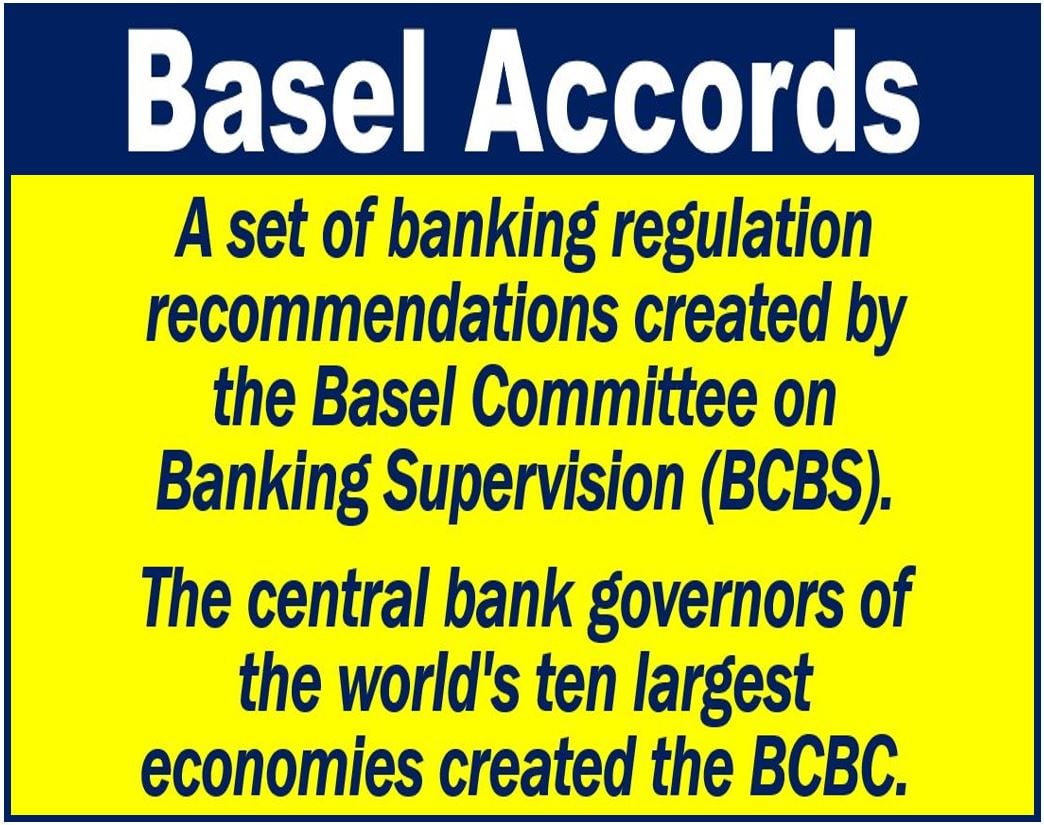Basel accords – definition and meaning
The Basel Accords are a set of banking regulation recommendations that the Basel Committee on Banking Supervision (BCBS) created. The BCBC is a committee of banking supervisory authorities. The governors of the central banks of the Group of Ten countries created the committee in 1974.
In other words, the Basel Accords are a set of banking regulations created by the world’s ten largest economies.
The BCBS provides a forum for regular cooperation on banking supervision matters.
The Group of Ten set up BCBS to ensure that banks operate safely and also soundly. Essentially, it serves as an international advisory authority on banking systems worldwide.
Just like any other business, banks are at risk of going bankrupt. Banks have a massive impact on national economies. In fact, the collapse of a major bank can bring a country’s economy to its knees.
Not only would a major bank’s collapse damage a country’s economy, but those of other countries too. The Wall Street Crash of 1929, for example, affected the US economy and subsequently other nations too.

Therefore, it is essential for the sake of an economy to establish rules and regulations. Regulators make sure that their banks adhere to the Basel Accords. Thus, we can keep the number of insolvencies and failures to a minimum.
The Basel Accords contain these rules and regulations.
According to the Basel Committee on Banking Supervision website:
“The Basel Committee on Banking Supervision provides a forum for regular cooperation on banking supervisory matters. Its objective is to enhance understanding of key supervisory issues and improve the quality of banking supervision worldwide.”
The Basel Accords have many aims. For example, they aim to ensure that banks maintain sufficient levels of capital. Above all, they want to make sure that banks continue lending during a serious financial crisis.

Three Basel Accords
The BCBS has produced three different Basel accords to date.
Basel I (1988)
This accord focused on capital adequacy ratio. Capital adequacy ratio or CAR is a measure of how well a bank can absorb loss. It is the ratio of capital to risk. In other words, it measures how well a bank could withstand a serious financial crisis.
It is thanks to a healthy CAR that banks are better at withstanding crises today.
Regulators had to compel banks to maintain capital equal to at least 8% of their risk-weighted assets.
Additionally, the Accord categorized the assets of financial institution into five risk categories:
- 0% – cash, central bank and government debt and any OECD government debt.
- 10% – public sector debt.
- 20% – development bank debt, OECD bank debt, OECD securities firm debt, non-OECD bank debt (under one-year maturity) and non-OECD public sector debt, cash in collection, and public sector debt.
- 50% – residential mortgages.
- 100% – private sector debt, non-OECD bank debt (maturity over a year), real estate, plant and equipment, capital instruments issued by other banks.
Basel II (2004)
Basel II expanded the number of risk buckets from four to six. This subsequently added a 150% risk category and a 35% risk category.
Basel III (2018)
Authorities implented this Accord on March 31, 2018.
Basel III says banks should maintain an amount of tier 1 capital equal to at least 6% of total risk-weighted assets. Additionally, they will have to maintain a total capital ratio of 10.5%.
Tier 1 capital is the bank’s common stocks and retained earnings. In other words, it is the bank’s core capital.

